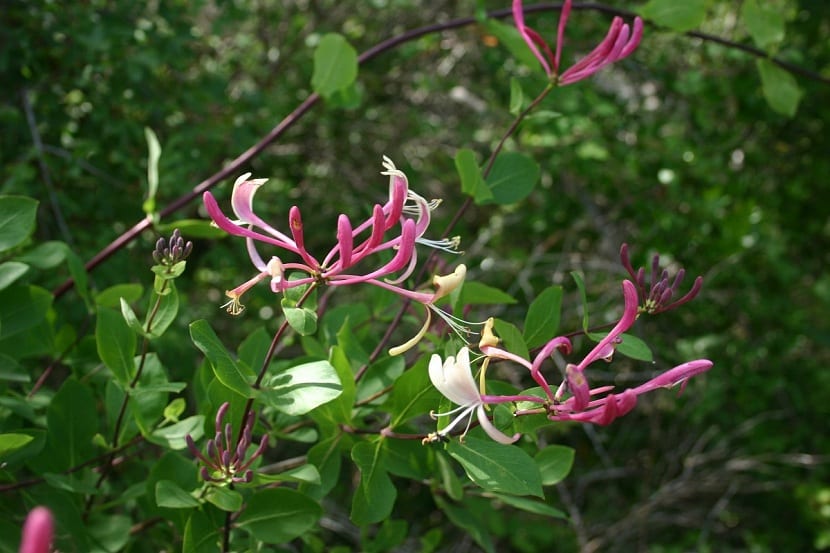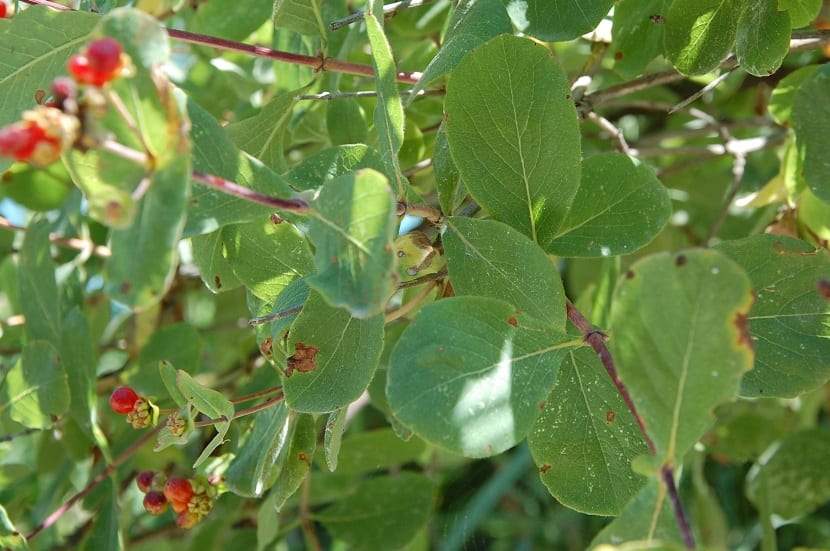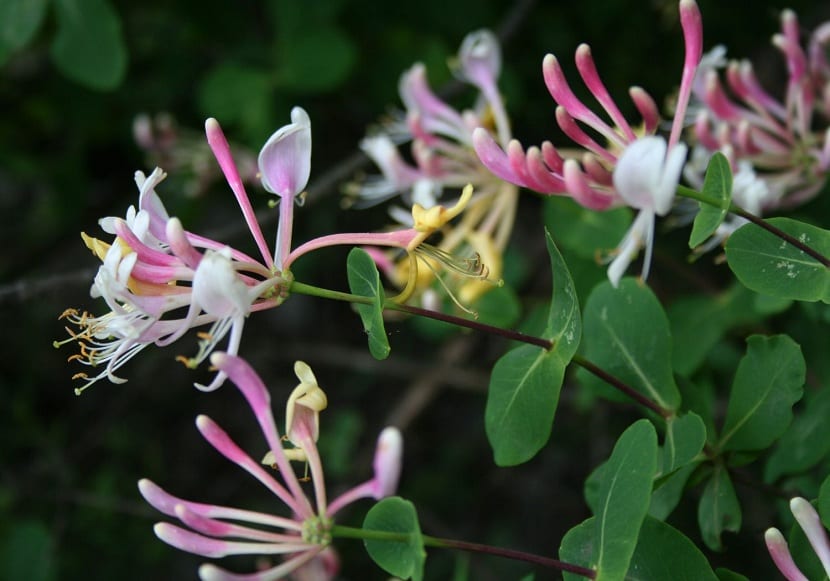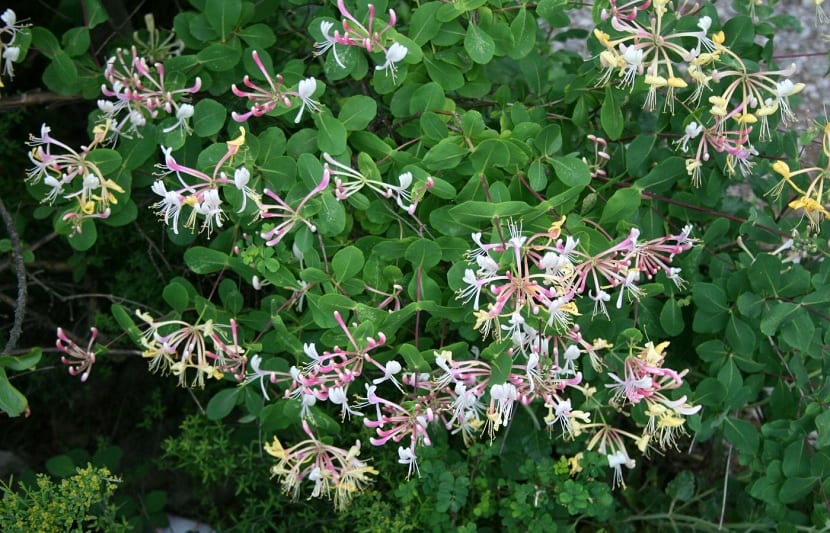
Today we are going to talk about a well-known plant that is used to decorate our garden. It's about the Etruscan Lonicera. It belongs to the Caprifoliáceas family and is also known by the name of Etruscan honeysuckle. The Etruscan name comes from its location where it is found in greater quantity and is in Etruria. It is one of the 100 species of shrubs and climbing plants that make up the genus Lonicera. It comes from southern Europe.
In this article we are going to explain everything you need to know about Etruscan Lonicera, from its characteristics and main uses to what care it needs to have it in the garden.
Key features

These are climbing shrubs with deciduous leaves. If conditions are good and growth has been adequate, It is capable of measuring about 4 meters in height. It has elliptical shaped leaves, with a bluish green color and they grow opposite the stem. The good thing about this plant is that it not only decorates visually, but also leaves an incredible fragrance. And it is that its flowers have a unique perfume. Its shape is tubular and with yellowish-white petals.
This plant blooms from mid-spring until the summer starts strong. High but mild temperatures are his favorites, since the extremes of summer do not suit him. As for its fruits, They are red berries inedible but quite decorative.
It lives naturally in more humid pine forests. If we want to find it in nature we have to go to the mountains around Banyeres de Mariola, being more abundant in the areas of the Sierra de Fontanelles.
Most frequent uses

La Etruscan Lonicera not only serves to decorate, but also has medicinal effects as we will see later. As usual, They are often used in homes to cover certain walls or decorate pergolas. To help them climb and grow, you need to guide them through some supports. They are also suitable for large pots and for placing both on patios and terraces. Its collection for medicinal uses is divided into: the leaves are collected during the flowering periods and the flowers a little earlier. The fruit is collected when it has a deep red color.
Among its active principles we find essential oil, salicylic acid, derivatives of monoterpenic iridoids, saponosides and mucilage. They also have tannins that are very useful concentrated in the stems. The medicinal properties of the flowers are of general stimulant, a laxative, antitussive, diuretic, sedative, sudorific, decongestant of the mucous membranes, expectorant, antirheumatic and antiasthmatic.
On the other hand, the leaves have properties similar to those of flowers and stand out for being diuretic and sudoriferous. Their use is not highly recommended as they can be somewhat more toxic. The Etruscan Lonicera It is usually used for the treatment of some diseases or pathologies such as spleen, hepatitis, gout, rheumatism, fluid retention, dropsy, bronchitis, stronger colds, cough, migraine, asthma, irritability, etc. It is also used for external treatments such as dermatosis, wounds, sores, ulcers or stomatitis.
Since its dose is difficult to guess if you are not a specialist or a doctor, domestic use is not recommended at all. This is because, being rich in saponins and in principles similar to nicotine, it can become addictive and have side effects such as diarrhea, vomiting, seizures, heart disease and even death. We must also be careful with the berries if we have children or pets since they are toxic due to their high content of saponosides. This active principle endows the fruits with drastic emetic properties. Of this plant, the only thing that is not considered toxic are the flowers.
Caring for the Etruscan Lonicera

This plant needs a semi-shade exposure. The direct sun does not favor it at all since it can damage its flowers. Above all, do not put them in the sun in the central hours of the day. On the other hand, if you place it in total shade, it can prosper, although it is not the most appropriate. Ideally, it should have a few hours of sun a day and be in the shade as well. When it is still in development, it is convenient to protect it in the flowering stage or close to summer so that it is not damaged.
It is not a demanding plant with the type of soil where it grows. Nevertheless, it tends to grow better if the soil has an alkaline pH and good drainage. This is essential if we want a good climbing plant in our garden. If the soil is saturated and does not drain the water well with a high degree of compaction of the soil, it will cause the irrigation water to be stored and end up drowning the roots.
Regarding irrigation, the ideal is to water it regularly. In summer, a deeper watering is necessary once a week since the heat is more intense and the need for water increases. The indicator that helps you know when to water is that the land does not dry out completely. When it's half drying out, it's time to water again.
Now Etruscan Lonicera A good compost with humus or compost comes in handy in the spring time and another in autumn. This serves to give it a good supply of nutrients when the flowers are developing and supporting higher temperatures typical of spring and summer.
Maintenance of the Etruscan Lonicera

Since it is a climbing plant, it can grow without control. It is convenient to help her with some kind of guide so that her path is more focused on the objective we want. Stems that are too long or have lost a large number of leaves should be pruned. We must also carry out a maintenance pruning at the end of winter, when the frosts have completely finished. If you want, you can leave that pruning for after flowering and not cause stress.
They are not plants that are attacked by typical garden pests or diseases. They are quite sturdy, generally.
If you want to multiply them, you can do it through seeds sown in spring or through cuttings Placed to root in a fairly humid soil with a sandy texture. Cuttings are best sown in spring or mid-summer.
I hope this information helps you to know more about the Etruscan Lonicera.